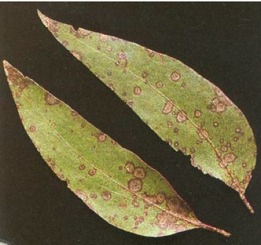PESTS AND DISEASES OF FORESTRY IN NEW ZEALAND
Aulographina Leaf Spot of Eucalyptus
Scion is the leading provider of forest-related knowledge in New Zealand
Formerly known as the Forest Research Institute, Scion has been a leader in research relating to forest health for over 50 years. The Rotorua-based Crown Research Institute continues to provide science that will protect all forests from damage caused by insect pests, pathogens and weeds. The information presented below arises from these research activities.
Forest Pathology in New Zealand No. 1,
1. Aulographina Leaf Spot of Eucalyptus.
Compiled: 1983, minor update 1990
Revised 2009
Fungus: Aulographina eucalypti (Cooke & Massee) von Arx & E. Müller
Type of injury
Leaves become disfigured but tree growth is not usually affected. However, heavy infestations may cause premature leaf drop or reduce photosynthesis.

Fig. 1 - Aulographina eucalypti on Eucalyptus fastigata .
Diagnostic features
Brown, roughly circular (2-15 mm in diameter) spots with a raised, crusty centre, and a dark margin on both sides of leaves and petioles. Spots on one side of the leaf are only rarely visible on the other side.
Minute (up to 2 mm long), black flecks (the fruiting bodies of the fungus) scattered on the leaf spots.
Hosts
Eucalyptus botryoides, E. delegatensis, E. fastigata, E. ficifolia, E. fraxinoides, E. globulus subsp. globulus, E. globulus subsp. maidenii, E. nitens, E. pilularis, E. regnans, E. saligna.
Distribution
Aulographina eucalypti is found throughout New Zealand.
Disease development
Initially small, circular, shield-like fruiting bodies of the asexual state develop on the surface of the lesion. These are followed by black, elongated fruiting bodies of the sexual state which are often branched and open by splitting along their length. The spores which initiate new infections are wind-dispersed and are discharged during periods of high humidity. Infection on new hosts occurs primarily in the lower crown. Young, expanding leaves are not susceptible. Infection of the new season’s foliage does not become evident until late summer.
Economic importance
Trees badly affected by A. eucalypti may have over 90% of their leaf area covered with lesions. This level of infection has been seen in E. regnans and E. delegatensis in some locations in the central North Island. Aulographina eucalypti is one of the suite of fungi associated with the foliage disease known as Barron Rd Syndrome. Other hosts are less affected with infection primarily occurring in the lower crown.
This fungus has been reported as causing serious defoliation of E. nitens in Victoria, Australia.
Control
Not considered necessary.
Bibliography
Dick, M. 1982: Leaf-inhabiting fungi of eucalypts in New Zealand. New Zealand Journal of Forestry Science 12: 525-537.
Dick, M.; Gadgil, P.D. 1983: Eucalyptus leaf spots. New Zealand Forest Service, Forest Pathology in New Zealand No.1.
Gadgil, P.D. 2005: Fungi on trees and shrubs in New Zealand. Fungi of New Zealand Volume 4. Fungal Diversity Research Series 16: 1-437
Ridley, G.S., Dick, M. 2001: An introduction to the diseases of forest and amenity trees In New Zealand. Forest Research Bulletin 220, Rotorua, New Zealand
This information is intended for general interest only. It is not intended to be a substitute for specific specialist advice on any matter and should not be relied on for that purpose. Scion will not be liable for any direct, indirect, incidental, special, consequential or exemplary damages, loss of profits, or any other intangible losses that result from using the information provided on this site.
(Scion is the trading name of the New Zealand Forest Research Institute Limited.)

 Farm Forestry New Zealand
Farm Forestry New Zealand

